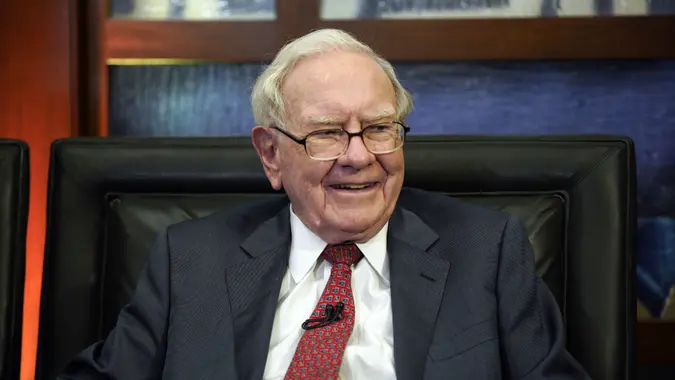Advertiser Disclosure
GOBankingRates works with many financial advertisers to showcase their products and services to our audiences. These brands compensate us to advertise their products in ads across our site. This compensation may impact how and where products appear on this site. We are not a comparison-tool and these offers do not represent all available deposit, investment, loan or credit products.
6 Key Signs You Need Help With Your Investment Strategy
 Written by
Andrew Lisa
Written by
Andrew Lisa
 Edited by
Gary Dudak
Edited by
Gary Dudak

Commitment to Our Readers
GOBankingRates' editorial team is committed to bringing you unbiased reviews and information. We use data-driven methodologies to evaluate financial products and services - our reviews and ratings are not influenced by advertisers. You can read more about our editorial guidelines and our products and services review methodology.

20 YearsHelping You Live Richer

Reviewed by Experts

Trusted by Millions of Readers
Investing is one of the keys to building wealth, but every dollar you invest is one that you risk losing — and strategies matter. From growth or value stocks to dividend income or real estate appreciation, your approach and choices will determine whether you succeed or fail over time.
One of the biggest roadblocks is a lack of self-awareness. If you’re overconfident, you might be reluctant to change your strategy even in the face of warning signs that say it’s time to adjust.
GOBankingRates spoke to investing experts who have seen people ignore these signs at their own peril. If any of the following apply to you, do your financial future a favor and get help in building a winning strategy.
You’re Consistently Underperforming Over Time
Anyone with just a few dollars and zero investing experience can match the market’s average performance with an S&P 500 index fund, which mirrors the stock market’s benchmark index. If you’re not doing at least as well as the greenest novice investor on a budget buying fractional shares of a single ETF, it’s time to adjust.
“One red flag is the inability to outperform the market despite your best efforts,” said Kevin Huffman, veteran day trader, market analyst and owner of Kriminil Trading. “It is a clear sign that your portfolio strategy needs a refreshment to better align with your stated objective and risk tolerance.”
Garrett Smith, a veteran financial advisor and CCO at Ascend Investment Partners, agrees. “While all investments can have short-term fluctuations, persistent lagging behind similar investment vehicles or indices suggests a mismatch in strategy, risk assessment, or asset allocation,” he said.
You Don’t Understand, Trust or Love Your Portfolio
Your portfolio should be your baby. You should trust your system even when you’re losing money and have faith in your selection of securities, the percentage of your holdings each one represents and your level of overall diversification.
Most importantly, you should know the purpose of all your holdings and why you chose each element of your portfolio in the proportion that you did. If you feel like some of your choices were guesses, or you’re frequently second-guessing your choices, it’s time to ask for help.
“Another tip-off is not being satisfied with your investment portfolio,” said Huffman. “Look out for people who keep questioning their strategy or can’t seem to grasp how it’s working. Such problems often signal that it’s time for a change. Lack of understanding or clarity typically leads to bad decisions.”
You’re Letting Your Emotions Steer Your Investment Decisions
If you don’t trust your choices or have faith in your portfolio, you’re vulnerable to emotional decision-making, which is a recipe for failure. If you find yourself panic-selling, bandwagon-buying or choosing stocks based on FOMO, you aren’t secure in your strategy and it’s time to forge a new path.
“An approach consistently eliciting panic or euphoria can indicate a misalignment between the investor’s financial plan and their psychological capacity to endure market fluctuations,” said Smith. “This emotional discord often suggests that the investment strategy is not genuinely tailored to the individual’s financial temperament or understanding, leading to decisions that could detract from long-term objectives.”
You’re Frequently Chasing Tips, Trends and Hype
Trend investing is adjacent to emotional investing, and if you’re buying and selling based on what’s buzzing, what’s grabbing headlines or what you think the next big thing might be, your portfolio probably needs some spring cleaning.
“Another red flag is if you’re always chasing after hot tips or diving headfirst into speculative investments,” said Tom Bruzek, a land investor and founder of Sell Land Fast. “It’s exciting to think about hitting it big, but relying solely on rumors or gut feelings without doing your homework? That’s a recipe for trouble. If you’re finding yourself in this cycle, it might be time to bring in a pro to help steer you in a more solid direction.”
Your Life Circumstances Changed but Your Strategy Didn’t
Major life events should trigger portfolio adjustments — or at least a reexamination of your overall strategy.
“If one’s financial situation has changed — for example, through a salary increase or a fire-sale purchase — then his or her current allocation might no longer be appropriate,” said Huffman. “Significant life events — such as getting married, having children, changing careers or getting close to retirement — are certainly triggers for reconsidering investment needs and changing your approach. Consulting a professional is wise to ensure that your investment strategy fits your current situation and long-term goals.”
Your Age Doesn’t Match Your Portfolio’s Risk Level
It’s not just changes in life circumstances that should guide your investment strategy. Your portfolio should align with your current stage of life and the appropriate level of risk tolerance, which evolves as you age. If not, it’s time to change course.
“For instance, a portfolio that’s overly conservative for a young investor with a long-term horizon or excessively risky for someone nearing retirement might signal a need for strategic realignment,” said Smith.
More From GOBankingRates
Share This Article:




You May Also Like


Boomers Have $472K in Investments -- Nearly Double the US Average, Study Finds
November 20, 2025
5 min Read

Self-Made Millionaire Codie Sanchez Shares the Best $1K Investment She Made
November 20, 2025
5 min Read

Buy These 4 ETFs if You Want to be Rich in 2026, According to John Liang
November 14, 2025
5 min Read

I'm a Financial Advisor: 5 Investing Tips To Combat a Frustrating Economy
November 20, 2025
5 min Read

Investment Pros Are Rebalancing Portfolios Amid Inflation Shifts: What You Can Learn
November 17, 2025
5 min Read

I'm an Investment Manager: 4 Timeless Lessons I've Learned From Warren Buffett
November 17, 2025
5 min Read


Why Warren Buffett Now Holds More Cash Than the Fed -- What That Signals About the Market
November 14, 2025
5 min Read





Suze Orman: These Are the 3 Biggest Mistakes You Can Make as an Investor
November 05, 2025
5 min Read
Make your money work for you
Get the latest news on investing, money, and more with our free newsletter.
By subscribing, you agree to our Terms of Use and Privacy Policy. Unsubscribe at any time.


Thanks!
You're now subscribed to our newsletter.
Check your inbox for more details.



Sending you timely financial stories that you can bank on.
Sign up for our daily newsletter for the latest financial news and trending topics.
For our full Privacy Policy, click here.
Looks like you're using an adblocker
Please disable your adblocker to enjoy the optimal web experience and access the quality content you appreciate from GOBankingRates.
- AdBlock / uBlock / Brave
- Click the ad blocker extension icon to the right of the address bar
- Disable on this site
- Refresh the page
- Firefox / Edge / DuckDuckGo
- Click on the icon to the left of the address bar
- Disable Tracking Protection
- Refresh the page
- Ghostery
- Click the blue ghost icon to the right of the address bar
- Disable Ad-Blocking, Anti-Tracking, and Never-Consent
- Refresh the page




